Contents
Raspberry chlorosis is caused by a decrease in the concentration of chlorophyll in the leaves, as a result, their shade changes to yellow. The cause of pigment deficiency can be both a lack of iron and infection with a virus. In the first case, dealing with the problem is quite simple, in the second – all that remains is to get rid of the affected bushes. There are no drugs effective for raspberry viral chlorosis yet.
What does raspberry chlorosis look like?
The main symptom is leaves that have turned yellow much earlier. The leaf plate may turn completely pale, or yellow “veins” on a green background are clearly visible on it.

If nothing is done, there is a strong slowdown in the development of chlorosis-affected raspberry bushes.
Varieties
Depending on the cause of development, two main types of chlorosis are distinguished. Less dangerous for raspberry bushes is what is called physiological or non-infectious (non-viral). In this case, the yellowing of the leaves of the plant “signals” a deficiency in the soil of nutrients. In most cases, they lack iron, less often manganese, boron, zinc. The situation is exacerbated by the gardener’s mistakes in care or the wrong choice of landing site. Raspberry chlorosis may be due to a lack of sunlight, regular waterlogging of the soil.
Non-infectious raspberry chlorosis does not require any treatment. It is only necessary to identify and eliminate the “destabilizing” factor (adjust watering, carry out appropriate feeding), and the condition of the plants will return to normal by itself.
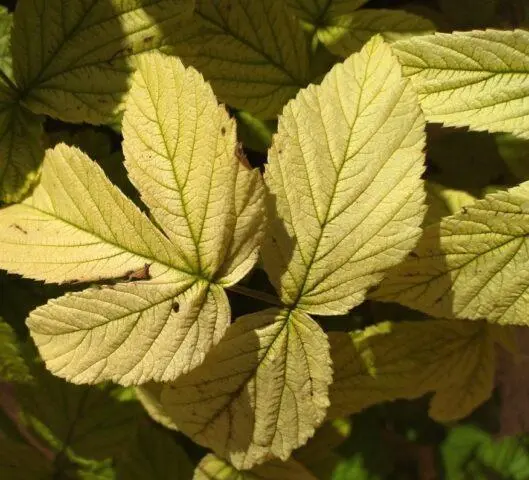
If the problem is noted repeatedly, treatment with biostimulants is recommended.
Raspberry carbonate or alkaline chlorosis is sometimes considered a separate variety. It is due to the planting of bushes in alkaline soil unsuitable for them (the culture also does not like the increased acidity of the soil, but it tolerates it better). From the photo it is obvious that the symptoms of carbonate and non-infectious raspberry chlorosis are identical. Its treatment consists in restoring the optimal soil pH for the culture (5.8-6.7). Excess alkali prevents them from absorbing nutrients normally.
Infectious raspberry chlorosis, caused by several different strains of viruses, is much more dangerous for bushes. The characteristic symptoms may be stronger or weaker, depending on the variety, plant immunity and cultivation conditions.
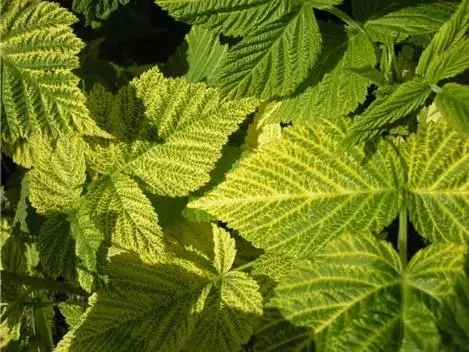
Effective means to combat infectious chlorosis do not yet exist.
What is dangerous chlorosis
Any kind of disease disrupts one of the most important processes for any plant – the production of chlorophyll. It is vital for photosynthesis, during which carbon dioxide is converted into oxygen and nutrients under the influence of sunlight.
As a result, raspberries are not able to provide themselves with everything necessary for the normal development, reproduction and ripening of fruits. The growth of bushes is greatly slowed down, shoots and leaves begin to gradually die off.
The virus is not afraid of frost, so a relapse of the disease is inevitable in the spring. Non-infectious chlorosis strongly “depresses” the immunity of the bushes, other problems gradually “join” it.
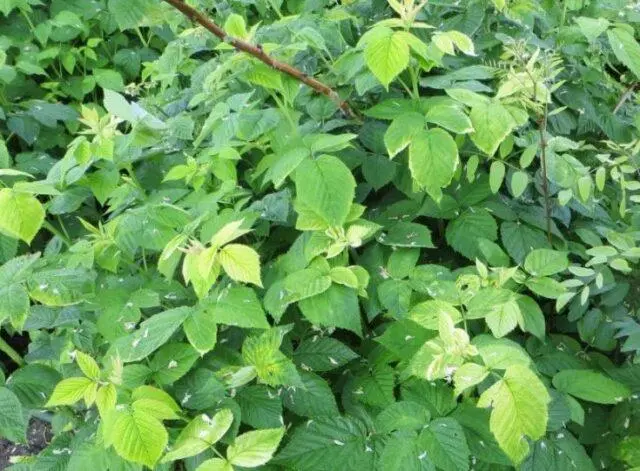
Raspberry chlorosis develops rather slowly, but after 2-3 seasons the bushes will die
Causes
In the vast majority of cases, the gardener himself is to blame for the development of non-infectious raspberry chlorosis, choosing a place for planting without taking into account crop preferences or making serious mistakes in care. Bushes “pick up” the virus most often from insects that feed on the juices of the plant (aphids, thrips, raspberry fly), which are its carriers.
However, the gardener himself can also contribute to infection with the virus. This is due to the neglect of the disinfection of garden tools and tools.

The virus is “sowed” on raspberries along with pest excrement
Symptoms
The main symptom is yellowing of the leaves (of the entire plate or the appearance of spots on it, “mesh”). He is accompanied by:
- shrinking leaves;
- elongated and thinned shoots, drying tops;
- dry, deformed berries, easily broken into separate drupes, almost tasteless or very sour;
- root rot;
- “massive” dropping of leaves, buds, fruit ovaries;
- gradually drying, curling leaf plates.

You can not expect a high-quality harvest from the affected bushes
Non-infectious chlorosis, depending on which macro- or microelements are lacking in raspberries, manifests itself in different ways:
- Iron. The opening young leaves are initially lighter than the rest, they quickly turn completely yellow.
- Nitrogen. The leaf plates turn yellow from the edge to the center, at the same time a dry “border” is formed along the edge.
- Magnesium. Blurry yellow spots are scattered randomly on the leaves.
- Bor. Yellowness extends to the entire leaf in the direction from the petiole to the tip, the oldest leaf plates are affected first.
- Manganese. Only the tissues between the veins turn yellow.
How to treat raspberry chlorosis
A viral disease, even at an early stage of development, cannot be treated. Only bushes affected by its physiological variety can be saved.
Treatment of raspberry chlorosis with iron sulphate
The most common cause of non-infectious raspberry chlorosis is iron deficiency. To “compensate” for the lack, 2-3 foliar fertilizing with iron sulphate is carried out with an interval of 3-4 days, it is bred according to the manufacturer’s instructions.
To enhance the effect, iron chelate is prepared from ferrous sulfate. In 2 liters of hot water (50-60 ° C) dissolve 5 g of citric acid, and then add 8 g of ferrous sulfate. The liquid is intensively stirred, and a flocculent precipitate often falls in it. The finished product is cooled and used for foliar top dressing.
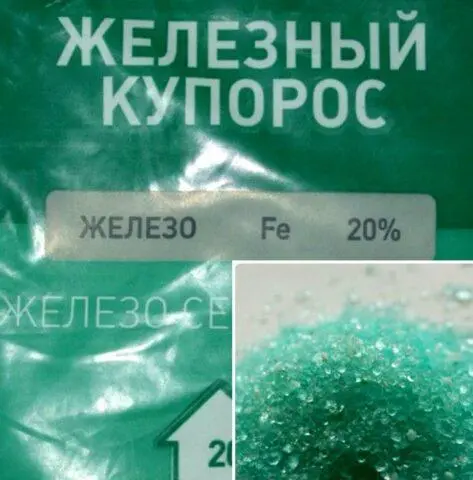
For better “sticking”, you can add a little small shavings of green potash or laundry soap to the solution, whipping it into foam
Preparations
You can buy ready-made iron chelate in the store. In addition to it, other drugs compensate for the deficiency of this microelement.
Ferovit
Contains a high concentration of iron chelate. This is a very effective stimulator of the process of photosynthesis and cellular “respiration” of plants. It is suitable for the prevention and treatment of non-infectious raspberry chlorosis.

Ferovit can be used to protect indoor plants, garden ornamental and fruit-bearing crops from chlorosis.
Brexil Fe
A drug specially created for the prevention of chlorosis in fruit and berry crops and the fight against it. One foliar feeding of raspberries is enough.
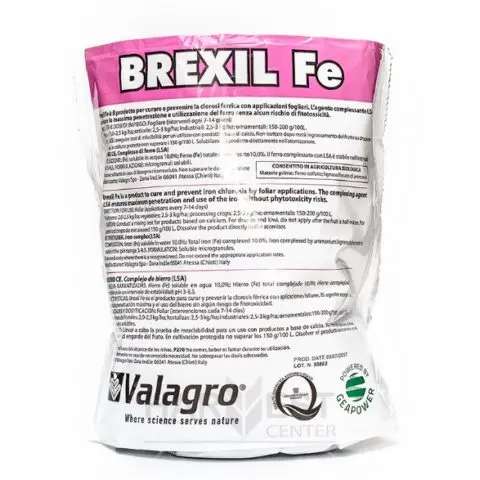
Brexil Fe is part of a series of preparations containing trace elements necessary for raspberries (iron, calcium, magnesium, manganese) in the form of chelates
Orton Micro-Fe
Universal fertilizer for indoor plants and horticultural crops. It contains not only iron chelate, but also other trace elements necessary for raspberries in case of chlorosis in an easily digestible form.
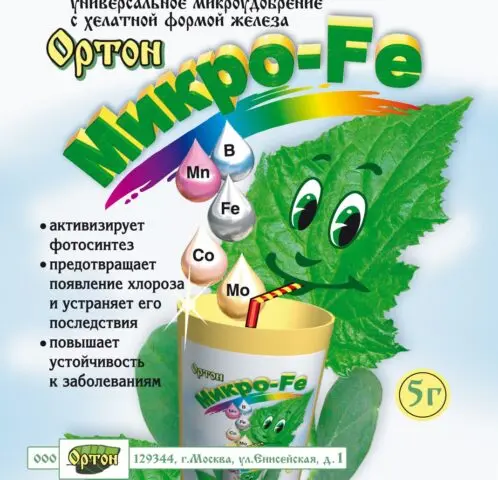
Feeding raspberries with Orton Micro-Fe has a positive effect on plant immunity
other methods
An old folk remedy for the prevention and control of raspberry chlorosis is to bury a small rusty nail under each bush when planting. Rust is iron oxide, which gradually “passes” into the ground and is absorbed by raspberry bushes. Therefore, such a tool will be quite effective and “long-playing”.
The only serious drawback of the folk method of dealing with raspberry chlorosis is that you can “disturb” the nail in the process of loosening, and then stumble upon it.
A similar result can be obtained by scraping off rust from somewhere and scattering it over a bed of raspberries. However, such a procedure for the prevention of chlorosis and the fight against it will have to be carried out annually.
Raspberry varieties resistant to chlorosis
Raspberry varieties that are guaranteed not to become infected with the virus do not yet exist. However, there are those who resist the disease much more successfully than others.
News of Kuzmin
Vigorous bushes with weakly branched shoots, bending under the weight of berries and in need of a garter. The variety is early ripe, cold-resistant, medium-yielding (1-1,5 kg per bush). The mass of the berry is 2,5-3 g, the shape is blunt-conical, the taste is pleasant, sweet and sour, with a slight spicy aftertaste.

Raspberry Novosti Kuzmina holds firmly on the stalk even after ripening, has good transportability
Collective farmer
Mid-season, frost-resistant, high-yielding variety. The bushes are sprawling, the shoots are dotted with thorns. The berries are large (2,5-3,5 g), elongated-cone-shaped, with a balanced sweet and sour taste.
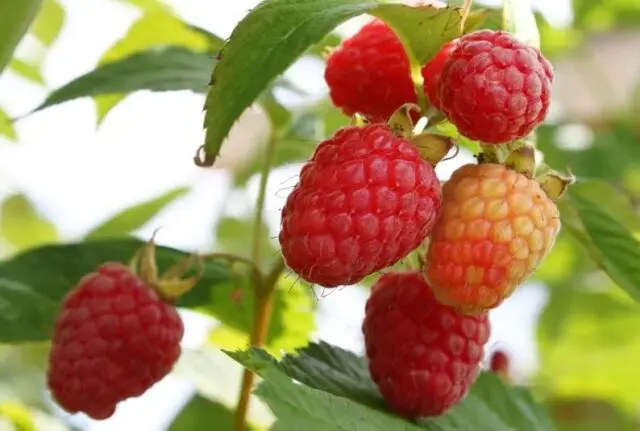
Raspberry berries Kolhoznitsa retain their characteristic taste and do not “fall apart” into separate drupes even after heat treatment
Hussar
A very unpretentious variety that tolerates drought and frost well. The shoots are powerful, upright, high (up to 3 m), do not require garters. The berries are conical, very large (10-12 g). The taste is pronouncedly sweet, with a slight sourness.
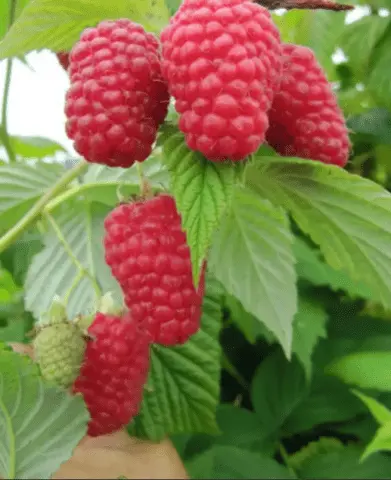
The high yield of raspberry Gusar (5-7 kg per bush) is ensured by the location of fruit branches along the entire length of the shoots
preventive measures
Simple prevention will help minimize the risk of developing raspberry chlorosis:
- selection of varieties with good resistance to the pathogen;
- providing the bushes with the necessary “living space”;
- refusal to place beds in the lowlands, planting raspberries in “heavy” soil;
- soil pH check;
- regular loosening and weeding of beds;
- application of complex fertilizers during the season to maintain plant immunity;
- immediate treatment of raspberries with insecticides or fungicides when suspicious symptoms are detected.
Raspberries affected by viral chlorosis cannot be spared. The bushes are uprooted and burned. You can’t put them in a compost pit or just “store” them on the site. In the place where the bushes grew, the soil with raspberry chlorosis requires disinfection by any means. Most often, it is shed with a 3% solution of copper sulfate or Bordeaux mixture.
Conclusion
Having found raspberry chlorosis on the bushes, it is important to understand what caused the yellowing of the leaves and the manifestation of “associated” symptoms. If the lack of chlorophyll is due to iron deficiency, it is quite easy to restore the healthy appearance of the bushes – you just need to provide them with the necessary trace elements. It is impossible to cure infectious chlorosis caused by a virus with modern means, therefore, attention must be paid to its prevention.









